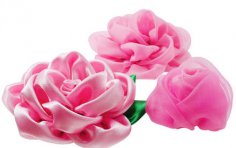
The Japanese word “kanzashi” has become popular in recent years among Russian crafters and fashionistas—albeit in the more pleasing Russian form “kanzashi.” Online resources offer countless master classes on making jewelry using this technique. However, in reality, silk and paper flowers are just one element that may or may not be present on a kanzashi, a traditional Japanese hair clip.
Kanzashi came to Japan from China, along with the fashion for elaborate Chinese hairstyles. The Japanese character for this hairpin also adopted it from Chinese. It consists of two elements, one of which translates as “fang” (corresponding to the hairpin's shape, which indeed resembles a sharp tooth), and the other as “saying,” meaning that kanzashi could reveal a lot about their owner, such as their social status and marital status.
However, as early as the first millennium BC—long before they encountered Chinese jewelry—the Japanese learned to fasten their hair with thin sticks whittled from tree branches or made from long fish bones. Such hairpins served not only a utilitarian purpose—to hold hair in place—but also a mystical significance: by using these sticks in one's hair, the ancestors of modern Japanese believed, one could remove the evil eye and ward off evil spirits.
Over time, jewelry became more complex. Several sticks placed together formed a comb, or kushi. And as early as the Nara period (8th century), Japanese travelers brought back kanzashi in a wide variety of styles from China. Over the following centuries, such jewelry sometimes fell out of fashion (for example, during the Heian period, from the 9th to the 12th centuries, when the Japanese began to favor simple hair “ponytails”), but always made a triumphant comeback.
In today's world, hairpins are more often considered a feminine accessory, but in medieval Japan, kanzashi were worn by everyone—men, women, and children. Consequently, the shape of the jewelry and the material from which it was made could vary greatly. For example, noblemen preferred ivory kanzashi, while members of the lower classes made do with wooden pins. Women's jewelry, meanwhile, became true works of art.
Japanese women began to adorn their hair with numerous hairpins in the second half of the Edo period (18th century). Kanzashi for wealthy women were then made from precious woods (sakura, boxwood, magnolia) and precious metals (silver and gold); sometimes, silver-plated or gilded brass pieces were used. The most expensive kanzashi were made from animal-based materials, such as tortoiseshell and crane bone. The hairpins were adorned with precious stones.
“Where are the hairpins with flower-shaped embellishments that have become so popular in Russia?” you might ask. Such kanzashi existed—and, in fact, continue to exist. However, in Japan, such hairpins, called hana-kanzashi, are traditionally worn only by apprentice geisha—maiko (in Kyoto) and hangeku (in Tokyo). Geisha themselves adorn their hair with simple yet elegant pins.
Incidentally, kanzashi are only supposed to be worn with a kimono. The combination of a traditional hairpin and a European dress is somewhat of a nonsense in the Japanese mind (at least, that was the case before the onset of active globalization).
Other rules also apply. For example, hana-kanzashi (hairpins with flowers) had to be chosen according to the season—there are 28 seasons in the Japanese calendar, each with its own flower. For example, in January, a geisha apprentice might wear a hana-kanzashi with pine, bamboo, and plum blossom decorations; in February, with tulips and daffodils; and in March, with peonies and peach blossoms.
The flowers are made from vibrant, hand-woven silk, and the crafting of the decorations has always been entrusted only to certified artisans who understand the history of kanzashi, study the compatibility of materials, and the significance of the decorations' shapes. However, today, tsumami—the silk flower-making technique based on origami—is practiced not only by professionals but also by amateurs.
If you'd like to get involved in this ancient art, why not? Just remember the correct names to avoid any embarrassment (what if you end up chatting with a real geisha?): kanzashi is a hairpin, hana-kanzashi is a hairpin decorated with artificial flowers, and tsumami is the technique for making these flowers.





